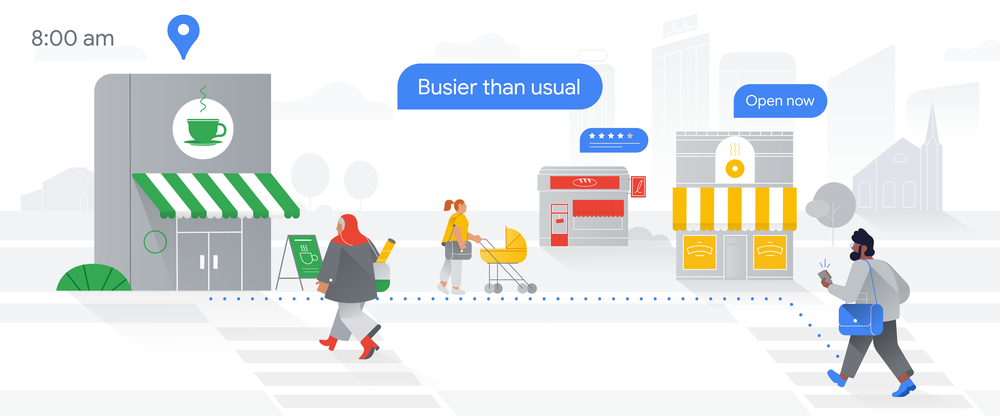
From Google:
Reduce hard-braking with routing updates
Imagine you’re driving to meet a friend. As you approach a busy intersection, the traffic slows suddenly and you have to slam on your brakes. According to research from experts at the Virginia Tech Transportation Institute, these hard-braking moments — incidents along a route that cause a driver to sharply decelerate — can be a leading indicator of car crash likelihood. Soon, Google Maps will reduce your chances of having hard-braking moments along your drive thanks to help from machine learning and navigation information.
Here’s how it works: Every time you get directions in Maps, we calculate multiple route options to your destination based on several factors, like how many lanes a road has and how direct a route is. With this update, we’ll take the fastest routes and identify which one is likely to reduce your chances of encountering a hard-braking moment. We’ll automatically recommend that route if the ETA is the same or the difference is minimal. We believe that these changes have the potential to eliminate 100 million hard-braking events in routes driven with Google Maps each year, so you can rely on Maps to get you from A to B quickly — but also more safely.
Sorry to be a killjoy, Google, but 'hard-braking moments' shouldn't happen if a driver is paying attention to the road in the first place. You'll be keeping an eye on ETA and alternatives at each junction, for which thanks Google, but otherwise you'll have seen stationary traffic some way off and there will be no need to brake hard. Ever. It's called being a good driver.
Walk this way with enhancements to Live View and detailed street maps
If you’re getting around on foot, we’ve got you covered with augmented reality in Live View. If you’re exploring a new neighborhood, you’ll be able to access Live View instantly — right from the map — and see helpful details about the shops and restaurants around you, like how busy they are, recent reviews and photos. We’ll also display helpful new street signs for complex intersections so you know exactly what road you’re on and which way to go. And if you’re traveling, Live View will tell you where you are in relation to places like your hotel — so you can always find your way back to home base.
Good to see - Google is wrong in saying (elsewhere) that it introduced a live view first - Nokia and HERE did this back in 2013. But with modern chipsets and data sophistication, of course Google is doing it better and in more detail.
Our detailed street maps feature, which launched last August, will soon be available in 50 more cities by the end of this year — including Berlin, São Paulo, Seattle, and Singapore. With the help of AI and our understanding of cityscapes around the globe, you can see where sidewalks, crosswalks and pedestrian islands are, along with the shape and width of a road to scale. This information can help pedestrians plan the most accommodating route, especially if they’re using a wheelchair or stroller.
Reported on here, good to see this continuing to roll out.
Spot busy areas at a glance
Each day, more than 80 million people turn to live busyness information on Google for specific places to save time waiting in line and stay socially distanced during the pandemic. Now, this is expanding to show the relative busyness of an entire area, like whether a neighborhood or part of town is busier than usual. If it’s Saturday morning and you want to explore your city without crowds bogging you down, open up Maps to instantly see busy hotspots to avoid — like the streets near the local farmers’ market. On the flip side, if you want to check out popular parts of town, use area busyness to scope out lively neighborhoods at a glance to discover interesting things to do.
A map tailored to you
Having information about the world is useful, but it can quickly become overwhelming if it’s not delivered at just the right time. To help you make sense of it all, we’re tailoring our map to highlight the most relevant places based on time of day and whether or not you’re traveling. If you live in New York and open up Maps at 8 a.m. on a weekday, we’ll prominently feature nearby coffee shops — instead of dinner spots — so you can start your day with a caffeine fix. And if you’re on a weekend getaway, it’ll be easier to spot local landmarks and tourist attractions right on the map. Want more options? Tap on any place to see similar places nearby.
Free mapping software on our smartphones has been a 'wonder of the world' since 2006 and Google Maps is now the gold standard, in terms of data integration from its live feeds, of traffic, businesses, opening hours, and human movement. Great to see it evolving still.
Google Maps is on all Android phones and a free download in the iOS App Store.

